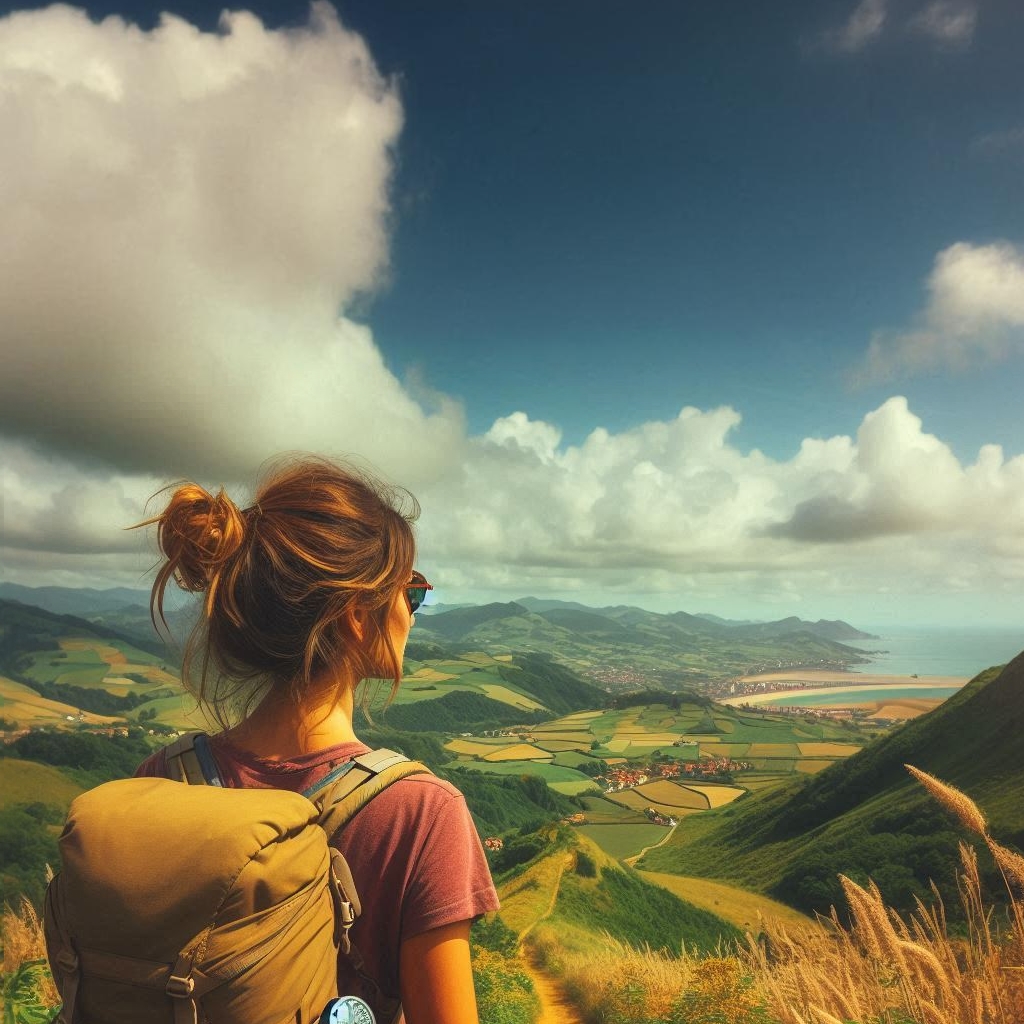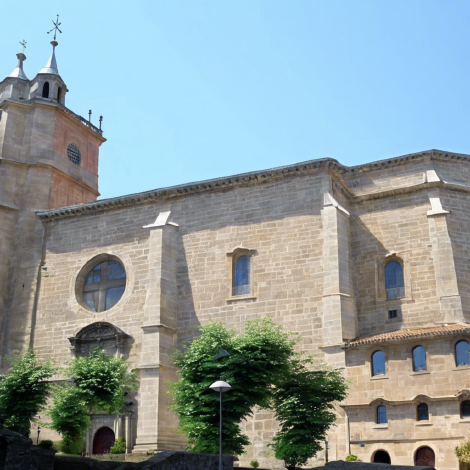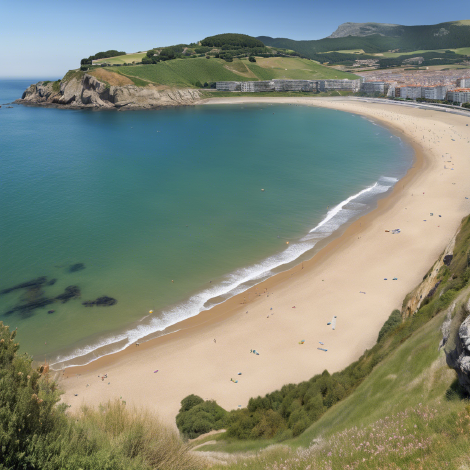
Irun to San Sebastián: Camino Del Norte Stage 1
Posted: | Updated:
Reading time: 13 minutes
Irun to San Sebastián: Camino Del Norte Stage 1
Posted: | Updated:
Reading time: 13 minutes
By: Simon Kemp, Editor
Route Description
The Camino del Norte , also known as the Northern Way, is one of the most popular pilgrimage routes to Santiago de Compostela in Spain. This first stage of the journey takes you from the town of Irun, located on the border with France, to the beautiful coastal city of San Sebastián.
Along the way, you’ll be treated to stunning ocean views, charming Basque villages, and a glimpse into the rich history and culture of the region.
Stage Distance
The distance from Irun to San Sebastián is approximately 24 kilometers (15 miles), and the estimated walking time for this stage is around 6-8 hours, depending on your pace and fitness level.
Detailed breakdown of the route
- The route begins in Irun, where you’ll follow the Camino markers through the town and out towards the coast.
- After crossing the Bidasoa River, you’ll enter the municipality of Hondarribia, known for its well-preserved medieval old town and impressive seaside fortress.
- From Hondarribia, the path continues along the coast, passing through the small fishing villages of Lezo and Pasaia before reaching the outskirts of San Sebastián.
- As you approach San Sebastián, the route takes you through the Antiguo neighborhood, where you’ll catch your first glimpse of the city’s iconic La Concha Bay and the towering Mount Igueldo.
- The final stretch of the stage leads you through the heart of San Sebastián, with the opportunity to explore the city’s beautiful old town, beaches, and lively pintxo (Basque-style tapas) bars.
Changes in terrain and elevation
The terrain along this stage of the Camino del Norte is predominantly flat, with a few gentle hills and inclines.
The path follows the coastline for the majority of the route, offering stunning views of the Cantabrian Sea and the surrounding mountains. The highest point of the stage is around 100 meters (330 feet) above sea level, near the town of Pasaia.
Points of interest along the route
Historical sites:
- The medieval old town and seaside fortress of Hondarribia
- The historic fishing village of Pasaia, with its charming harbor and traditional architecture
Natural features:
- The Bidasoa River, which marks the border between Spain and France
- The rugged coastline and sandy beaches of the Basque Country
- The towering Mount Igueldo, which overlooks the city of San Sebastián
Local landmarks:
- The iconic La Concha Bay and its crescent-shaped beach in San Sebastián
- The lively pintxo bars and restaurants in the old town of San Sebastián
Potential challenges or difficulties
This stage of the Camino del Norte is generally considered to be relatively easy, with a mostly flat and well-marked path. However, there are a few potential challenges to be aware of:
- The path can be exposed to wind and rain, especially along the coastal sections, so be prepared with appropriate clothing and gear.
- The rocky and uneven terrain in some areas may require extra caution, especially for those with mobility issues or carrying heavy packs.
- The final approach to San Sebastián involves navigating through urban areas, which can be more crowded and congested than the rural sections of the route.
Rest stops
Along the way, you’ll find several towns and villages where you can rest, refuel, and explore the local culture:
- Hondarribia: This charming town offers a variety of cafes, restaurants, and accommodations for pilgrims.
- Pasaia: The historic fishing village of Pasaia has a few small cafes and shops where you can take a break.
- San Sebastián: As the final destination of this stage, San Sebastián provides an abundance of options for food, lodging, and sightseeing.
Map of Camino del Norte Stage 1
Depart From: Irun

Irun is a picturesque town situated on the northern coast of Spain which serves as the starting point for pilgrims embarking on the Camino del Norte, one of the historic pilgrimage routes leading to the revered Santiago de Compostela.
With a rich history dating back to the Roman era, Irun’s strategic location at the border between Spain and France has made it a significant crossroads for travelers throughout the centuries.
Historical Background
Irun’s origins can be traced back to the Roman settlement of Oiasso, which served as an important port and trading hub during the Roman occupation of the Iberian Peninsula.
Over the centuries, the town has witnessed the passage of numerous pilgrims, from medieval knights to modern-day trekkers, all drawn to the spiritual journey of the Camino.
Notable figures such as the French king Louis XI and the Spanish queen Isabella I have passed through Irun on their way to Santiago de Compostela, leaving an indelible mark on the town’s history.
Main Attractions & Points of Interest
Irun’s rich cultural heritage is evident in its well-preserved historical landmarks.
- The 16th-century Iglesia de Nuestra Señora del Juncal (Irun Cathedral), a stunning example of Gothic architecture, stands as a testament to the town’s religious significance.
- The Iglesia is also the starting point of the Camino del Norte. This is where you can get your credential (the pilgrim passport).
- The Puente Internacional, a striking bridge that spans the Bidasoa River, connects Irun to its French counterpart, Hendaye, and serves as a symbolic gateway between the two countries.
- Museo Romano de Oiasso offers visitors a glimpse into the town’s Roman past, showcasing archaeological artifacts and interactive exhibits.
Pilgrim’s Services
Irun caters to the needs of pilgrims with a range of accommodations and services. The town boasts several albergues, or hostels, that provide affordable and comfortable lodging for those embarking on the Camino.
Numerous hotels and guesthouses also welcome weary non-pilgrim travelers, catering to various budgets and preferences.
Here are some of the best-known albergues in Irun.
- Albergue de Peregrinos de Irùn - A popular starting point for the Camino del Norte journey.
- Hotel Aitana - Located next to the Puente de Santiago Bridge, marking the beginning of the northern section of the Camino de Santiago Pilgrimage Route.
- Hotel Alcazar Irun - Offers accommodation with a garden and terrace, less than 1 km from FICOBA (the exhibition hall of Gipuzkoa).
- Pension Europa - Located 300 metres from Hendaye Railway Station and offers a restaurant and free WiFi.
Top-rated Hotels in Irun
If you need something more upmarket than an Albergue to start your Camino adventure, or are just here for a long-weekend, then here are some of the best hotels in the town:
Hotel Urdanibia Park:
- Located opposite Real San Sebastián Golf Club.
- Within 10 minutes’ drive of the city center and beaches at Hondarribia and Hendaya.
- Offers free Wi-Fi and outdoor parking.
- Features large, air-conditioned rooms with satellite TV and work desks.
- Onsite restaurant, café, and terrace available.
- Set in gardens with a children’s play area and a lounge with satellite TV.
ibis Irun:
- Budget hotel suitable for business and leisure.
- Modern, cozy rooms with the new Sweet Bed by ibis.
- Features 76 air-conditioned rooms with Wi-Fi access, including 3 adapted for disabled persons.
- Restaurant, bar, snacks available 24/24, a terrace, and free private outdoor closed parking provided.
- Meeting room available for booking.
Kyriad Direct Eth Irun:
- Aims to provide a relaxing and enjoyable stay.
- Located close to landmarks like Ermita de Santa Elena and Parroquia Nuestra Senora del Juncal.
- Air-conditioned rooms with free Wi-Fi.
- On-site restaurant and free parking available.
You can find a variety of dining options, from traditional Basque cuisine to international fare, as well as essential services such as pharmacies, medical facilities, and a pilgrim’s office that can provide information and assistance.
Local Customs & Traditions
Irun’s vibrant cultural identity is celebrated through various festivals and traditions. The Semana Grande, or “Big Week,” is an annual summer festival that features lively music, dance performances, and traditional Basque games.
The town also hosts the Fiesta de San Marcial, a religious celebration honoring the town’s patron saint, which includes processions, fireworks, and culinary specialties.
Natural Beauty & Surroundings
Irun’s natural setting is equally captivating, with the town nestled between the Cantabrian Sea and the rolling hills of the Basque Country. Enjoy scenic walking routes along the coast, offering breathtaking views of the rugged cliffs and pristine beaches.
The nearby Bidasoa River and its lush riverbanks provide opportunities for relaxation and exploration, while the surrounding hills and forests offer ample opportunities for hiking and outdoor activities.
Personal Experiences & Testimonials
“Irun was the perfect starting point for my Camino journey. The town’s rich history and warm hospitality immediately set the tone for my pilgrimage. As I crossed the Puente Internacional, I felt a sense of excitement and anticipation for the journey ahead.” - Sarah.
“The Iglesia de Nuestra Señora del Juncal was a highlight of my time in Irun. Standing in its towering presence, I couldn’t help but feel a deep connection to the countless pilgrims who had passed through these doors over the centuries.” - Miguel.
Practical Information
Irun is easily accessible by public transportation, with regular bus and train services connecting the town to major cities in Spain and France.
The best time to visit Irun is during the spring and autumn months, when the weather is mild and the crowds are smaller.
You can find ATMs, supermarkets, and other essential services throughout the town, ensuring a smooth and well-supported start to their Camino journey.
Arrive at: San Sebastián

San Sebastián, also known as Donostia, is a picturesque coastal city located in the Basque Country of northern Spain.
It serves as an important stop along the Camino del Norte, one of the main pilgrimage routes of the Camino de Santiago.
With its stunning beaches, historic architecture, and vibrant cultural scene, San Sebastián has long been a popular destination for both pilgrims and tourists alike.
The city’s origins can be traced back to the 12th century, when it was founded as a fishing village.
Over the centuries, San Sebastián has evolved into a thriving urban center, known for its stunning natural beauty, world-renowned cuisine, and rich Basque heritage.
Historical Background
San Sebastián’s history is closely intertwined with the Camino de Santiago. Throughout the Middle Ages, the city served as a key waypoint for pilgrims traveling the Camino del Norte, offering them a chance to rest, resupply, and seek spiritual renewal before continuing their journey to Santiago de Compostela.
Many famous historical figures have passed through San Sebastián on their way to the shrine of St. James, including the French king Louis XI, who is said to have visited the city in 1463.
The city’s strategic location and its role as a hub for pilgrimage have also shaped its cultural and architectural development over the centuries.
Main Attractions & Points of Interest
San Sebastián is home to a wealth of cultural and historical attractions that are of great interest to Camino pilgrims.
The city’s most iconic landmark is the Catedral del Buen Pastor, a stunning neo-Gothic cathedral that dominates the skyline.
Visitors can also explore the historic Old Town (Parte Vieja), with its charming plazas, narrow streets, and traditional Basque architecture.
Another must-see attraction is the Castillo de la Mota, a 12th-century fortress that offers panoramic views of the city and the surrounding coastline.
The city’s museums, such as the San Telmo Museum and the Museo de San Sebastián, provide valuable insights into the region’s history and cultural heritage.
Pilgrim’s Services
San Sebastián offers a wide range of accommodations and services catered to the needs of Camino pilgrims. The city boasts several albergues, or hostels, that provide affordable and comfortable lodging for those walking the Camino.
Albergues in San Sebastián
These albergues often have a communal atmosphere, allowing people to connect with one another and share their experiences. Here are some of the most popular:
Albergue/Auberge ULIA Youth Hostel: Modern rooms with private bathrooms and an on-site restaurant and bar. Located 15 minutes’ drive from Playa de la Zurriola Beach.
UBA Hostel: Colorful hostel with modern rooms and dormitories, free Wi-Fi, and a terrace with park views. Located 4 km from the center of San Sebastián.
Ur-Alde: Small familiar accommodation in the heart of the city with modern rooms inspired by different cities. Offers private bathrooms with hydro massage shower.
Koisi Hostel: Stylish hostel with air-conditioned rooms, communal terrace, and a restaurant offering traditional pintxos. Located 800 meters from Ondarreta beach.
In addition to albergues, San Sebastián also has a variety of hotels, hostels, and other accommodation options to suit different budgets and preferences. Whatever you choose, you will need a good night’s rest for day 2 of your Camino which is del Norte Stage 2 from San Sebastián to Zarautz .
Best Hotels in San Sebastián
Again,for an up-market option if you are on holiday rather than a Camino pilgrimage, here are some of the best hotels to look out for in the city:
Hotel Maria Cristina: This Luxury Collection Hotel is renowned for its sophisticated style and luxurious accommodations. It features elegant rooms with city views, a fitness center, and a renowned restaurant offering Basque cuisine.
Hotel de Londres y de Inglaterra: A historic hotel with a beachfront location, offering classic decor, sea-view rooms, and a terrace bar overlooking La Concha Bay.
Hotel Akelarre: A hotel that’s part of the Michelin-starred Akelarre restaurant, offering modern and stylish rooms with panoramic views, a wellness center, and an innovative gastronomic experience.
The city’s vibrant food scene includes numerous cafes, restaurants, and traditional Basque eateries, offering a wide range of local and international cuisine.
You can also find plenty of medical facilities, pharmacies, and other health-related services in San Sebastián, should the need arise during your journey.
The city’s Pilgrim’s Office, located in the Old Town, provides information, assistance, and support to those walking the Camino.
Local Customs & Traditions

One of the city’s most famous events is the San Sebastián International Film Festival, which attracts filmmakers and cinephiles from around the world each September.
The city also hosts a variety of traditional festivals and celebrations, such as the Tamborrada, a 24-hour drum festival held on the Feast of St. Sebastián (January 20th).
Locals and visitors alike can immerse themselves in the Basque way of life by exploring the city’s pintxos (Basque tapas) bars, attending traditional music and dance performances, or participating in local sports like pelota.
Natural Beauty & Surroundings
San Sebastián is renowned for its stunning natural setting, nestled between the Bay of Biscay and the Cantabrian Sea.
The city’s three iconic beaches – La Concha, Ondarreta, and Zurriola – are popular destinations for swimming, sunbathing, and enjoying the breathtaking coastal views. Beyond the beaches, the surrounding area offers numerous opportunities for outdoor activities and exploration.
You can can hike the scenic trails of Mount Igueldo, which offer panoramic vistas of the city and the coastline. The nearby Parque Natural de Aiako Harria, a protected natural area, provides opportunities for hiking, birdwatching, and connecting with the region’s rich biodiversity.
Personal Experiences
“Arriving in San Sebastián was a true highlight of my Camino journey. The city’s stunning beaches, vibrant culture, and warm hospitality provided a much-needed respite after the long days of walking. I’ll never forget the sense of peace and renewal I felt as I strolled through the Old Town, savoring the local pintxos and taking in the breathtaking views.” - Sarah
“San Sebastián left a lasting impression on me. The city’s rich history and Basque heritage were palpable at every turn, from the imposing Catedral del Buen Pastor to the lively pintxos bars. As I sat on the beach, watching the waves crash against the shore, I felt a deep sense of gratitude for the opportunity to experience this remarkable place along the Camino.” - Michael
Practical Information
San Sebastián is well-connected to the rest of Spain and Europe, with regular bus and train services available.
The city’s main bus station and train station are both located in the city center, making for easy access.
The best time to visit San Sebastián is during the spring and fall months, when the weather is mild and the crowds are smaller.
Summers can be quite busy, with high temperatures and increased tourism.
Be aware that some services and attractions may have reduced hours or be closed during the winter months.
San Sebastián has a range of other amenities and services that cater to the needs of Camino travelers, including ATMs, supermarkets, and pharmacies.
Pilgrims are encouraged to plan their stay in the city and make any necessary arrangements in advance to ensure a smooth and enjoyable experience.
